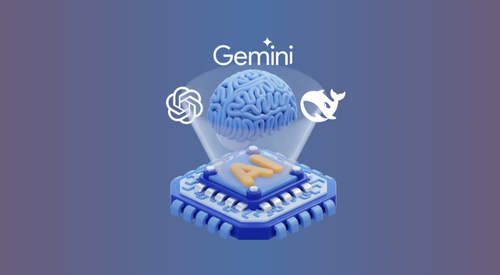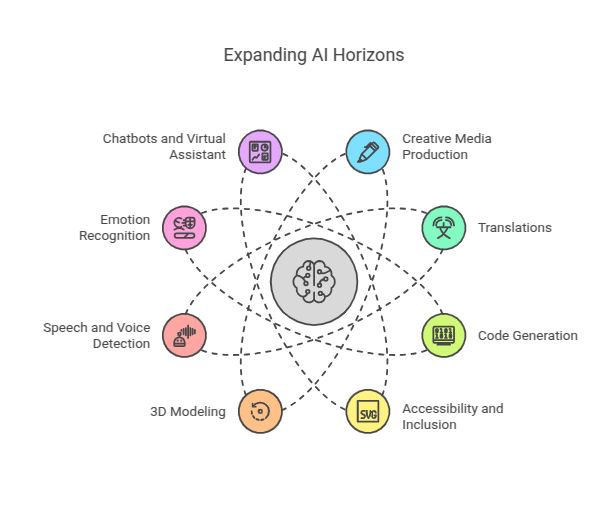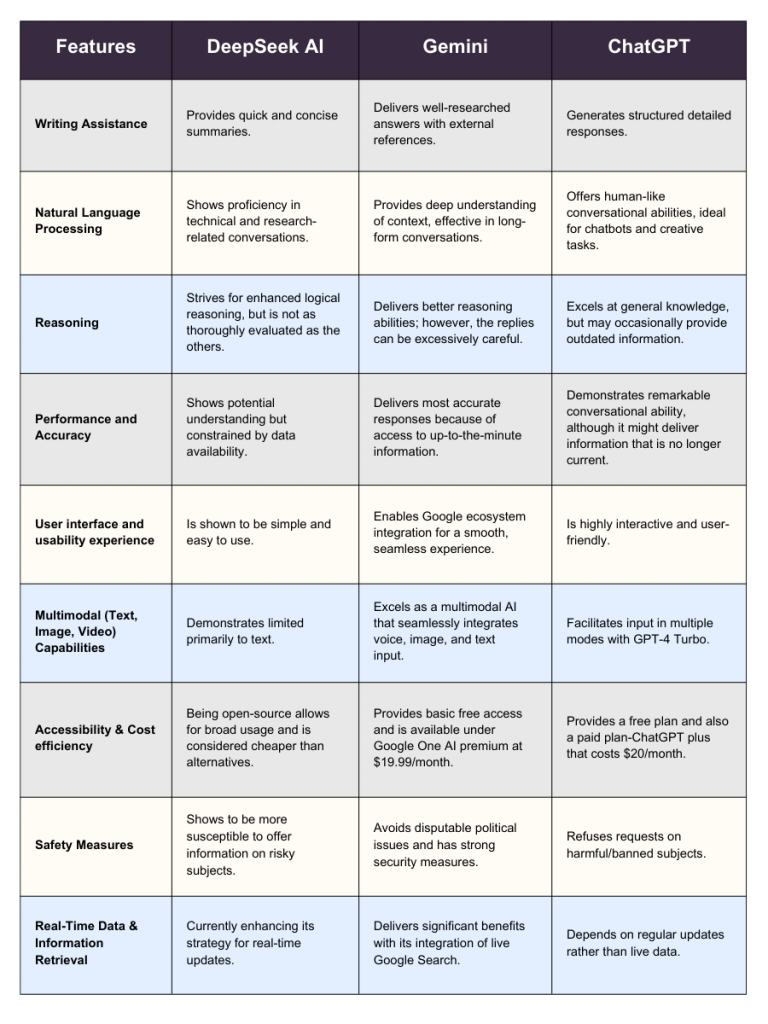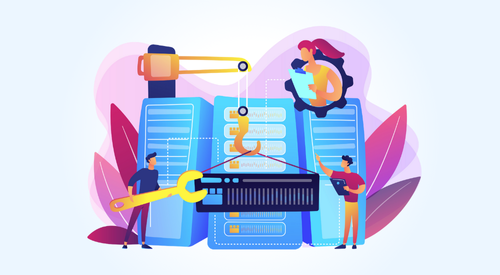

As per a 2024 McKinsey report, Gen AI could add between $2.6 trillion to $4.4 trillion annually to the global economy. With this potential, companies like JP Morgan Chase are investing over $ 1 billion annually in AI capabilities. Artificial intelligence has evolved beyond being just a buzzword in the tech sector; it now fundamentally transforms how we consume content. In this blog, we will explore the evolution of AI in content generation, an analysis of Google vs. OpenAI vs. DeepSeek, and the future of content generation.
Next-gen AI for Smarter and Faster Content Creation.
AI has progressed rapidly, transitioning from simple text models to advanced chatbots and virtual assistants in less than ten years—a significant difference compared to the 50 years between the invention of the first computers and the arrival of personal computers. When examining Google vs. OpenAI vs. DeepSeek, we can see how rapidly the AI models are evolving to chase new frontiers.
The initial iterations of AI consisted mainly of mathematical models and rule-based systems used to solve mathematical equations and run chess simulations. However, the technology is now analyzing data, predicting scenarios, automating tasks, enabling personalization, and even generating audio and visual content.

Image 1: A timeline showcasing the evolution of AI
Google vs. OpenAI vs. DeepSeek: Evolution of Next-Gen AI Models
The actual economic breakthrough of GenAI began to make an impact in the year 2022 with the public release of ChatGPT. As an intuitive, user-friendly interface, the generative AI model provided unprecedented access to powerful AI capabilities. The platform was made widely available, reaching 100 million users within just two months of its launch. Simultaneously, Google also introduced Gemini, a multimodal AI system that can comprehend and produce text, images, and audio, allowing for sophisticated reasoning. The Gemini Model has a significant market presence, raking in around 275 million users each month.
Meanwhile, Deepseek, a Chinese AI startup, quickly rose to prominence with its open-source model, topping the app charts in US app stores when it went public with its service in 2024. By utilizing cost-effective training methods and implementing sophisticated engineering enhancements like its mixture-of-experts (MoE) design, DeepSeek has markedly decreased the performance gap with leading proprietary models.
The rapid adoption of AI marks the significant benefits it carries. Since its introduction in commercial use, businesses in almost every sector have leveraged AI in one form or another. Platforms that are built on or enabled by AI have been integrated into their everyday operations.
AI has emerged as a crucial instrument for improving productivity and accelerating creativity, from improving content creation and data analysis to automating customer interactions. Although GenAI is relatively new, it has opened up a wider range of applications across industries. A few of the use cases that an AI model can deliver is as follows:
- Content Generation: Audio/video/text generators that are accelerating content creation for marketing and other business use cases. This includes 3D modeling, real-time translations, and more.
- Content Analytics: Analyzing large volumes of content with Speech and Voice analysis with integrated emotion recognition
- Customer Assistance and Data Analysis: Improving service efficiency and providing actionable insights.
- Accessible Information: Ensuring data is available and comprehensible to everyone.
- Increased Productivity: Optimizing workflows to reach greater efficiency and output.
And much more.

Image 2: A snapshot of use cases with GenAI
With new entrant DeepSeek, the AI market has undergone a paradigm shift. It has highlighted a broader trend in this industry, which prioritizes tailored, high-accuracy applications that address specific needs over general, all-purpose tools that are spread over multiple use cases.
Emergence of DeepSeek
DeepSeek is a free chatbot powered by AI launched in 2024, resembling ChatGPT in appearance, functionality, and usage. While it can perform many of the same tasks, its effectiveness compared to competitors is still a topic of discussion and debate. It is said to be as capable as OpenAI’s o1 model, which was launched in 2022, especially in areas like mathematics and coding. Similar to the o1 model of Chat GPT, R1 is classified as a “reasoning” model.
These models generate responses step by step, mimicking the way humans think through issues or concepts. This improves user experience and productivity by enabling companies to tailor AI interactions to meet their unique requirements. The new player carries significant pros and cons when compared to the first Generative AI models, which make up the major basis of the Google vs. OpenAI vs. DeepSeek conversation.
Comparing Google vs. OpenAI vs. DeepSeek
When comparing Google vs. OpenAI vs. DeepSeek, the strengths in the distinctive domains of each AI model are quickly evident.
Strengths of DeepSeek:
The company has brought disruptive innovations that have quickly challenged the existing industry status quo.
- Affordable Development Costs: DeepSeek R1 was developed for less than $6 million in comparison to ChatGPT, which makes it more affordable for users.
- Growing Influence in China: This model has posed a challenge to the US-dominated AI arena, decentralizing control and access to advanced AI tech.
- Open-Source Disruption: DeepSeek R1, with its zero-pricing model and transparent nature, provides a boon for users against the subscription-based revenue model of other big AI firms.
Strengths of OpenAI’s ChatGPT:
ChatGPT, on the other hand, is endowed with multipronged applications, especially in business and creativity enhancement.
- Business Support & Customer Traffic: It can deliver automatic responses to customers and hence improve operational efficiency.
- Education & Learning: It can serve as a tutor by helping with research, writing, and other projects.
- Content Creation: It can aid in brainstorming ideas, tell some stories, and automate content generation.
Strengths of Google Gemini:
Google’s Gemini, however, possesses the biggest advantage with its ability to access real-time information along with processing multiple forms of media.
- Fact-Checking & Research: Google Gemini is specifically advantageous for users who require verified, reliable, and updated information.
- Live Updates: Using Google Search it helps provide minute-by-minute answers, hence becoming a more reliable system with real-time responses.
- Multimodal Capabilities: Gemini can formulate text, images, and even code into its AI experience.


Image 3: A visual guide to choosing the right AI platform.
Google vs. OpenAI vs. DeepSeek: Future of AI in Content Creation
As AI-powered content generators evolve rapidly, we find business pan industries are at a precipice of transformation and evolution. As new tech breaks ground, we can note a barrage of new trends evolving in the business arena. As AI-led innovations take center stage, the digital landscape will be colored by trends such as:
- Hyper-personalization of Content: AI will deliver higher degrees of personalized content tailored to individual tastes.
- Advanced Multimodal Capabilities: The future of multimodal AI rests on achieving a more profound comprehension, broadening the types of modalities, ensuring ethical progress, and more.
- Wider accessibility: AI tools will become much more cost-effective and more widely available, democratizing content creation and improving information accessibility
- Ethical AI: As AI develops, discussions around responsible AI use, ways to mitigate bias, and data privacy will become prominent.
The Impact of AI Disruptions and the Future of Content Creation
The introduction of AI signifies a major upheaval in content creation – it is redefining the rules of creation and expanding the definition of creators. Much like how computers radically transformed animation by simplifying workflows and opening up new creative avenues, AI is redefining content creation through task automation, improved personalization, and broader creative possibilities. Generative skills that were previously reserved for experts and trained individuals are now more broadly available, reshaping occupations and job descriptions.
This upheaval emerges within a changing media environment marked by the growth of influencer culture and citizen journalism, where individuals are gaining greater control over narrative formation. AI technologies further broaden access to content creation, elevating the voices of the less mainstream information dispensers. This simultaneously prompts concerns regarding authenticity and the dissemination of false information.
This brings about the need for Generative AI to augment human intelligence rather than replace it. Essentially, viewing AI as a tool that boosts human productivity and collaborates alongside people instead of being a substitute for them is crucial. This human-in-the-loop method guarantees that the content remains engaging and avoids becoming mechanical or predictable. You can find applications for generative AI at nearly every phase of the creative workflow – including brainstorming, planning, storyboarding, drafting, verifying facts, and sharing with the audience.
However, effective content typically succeeds for two main reasons – it presents something novel, like an original concept, and fosters an emotional bond with the audience. The following are some trends to be expected in AI-driven content generation –
Trend 1: AI Adoption in Marketing
In recent surveys, around two-thirds of marketers were using GenAI for common marketing applications. The most common applications of AI were using it to support copywriting for email marketing, organic search, and social media.
The Niveus MarTech Platform, for example, leverages GenAI to accelerate the marketing processes. The platform streamlines the creation, oversight, and distribution of marketing materials, all personalized and adhering to specified brand guidelines. The platform can begin with generating campaign briefs as per prompt and ultimately generate textual and visual content tailored for different social media platforms.
Trend 2: Multimodal Applications in AI
Going beyond various input formats (such as text, image, video, and audio), we can expect Interconnected Modality Comprehension. The AI would be able to associate information across different modalities. For instance:
- Creating a caption for a visual (linking text with an image).
- Responding to queries about a video (connecting text to video).
- Converting audio into text while recognizing the emotions of the speaker.
Trend 3: Contextual Combination
Following through on multimodality, Contextual Combination can be a step further in seamless interaction. Multimodal AIs can merge contextual data from various modalities to deliver more comprehensive insights. For example, a virtual assistant employs speech (audio), semantic understanding of language (text), and visual signals (images or gestures captured by a camera) for seamless interaction with a user. This is what Gemini is successfully demonstrating through its various applications.
Conclusion
Artificial intelligence has now become a tangible reality rather than a concept of the future. What were once the extraordinary elements of a sci-fi movie have now become a part of our daily operations. The rivalry between Google vs. OpenAI vs. DeepSeek has accelerated AI advancements at an extraordinary pace. While each model offers distinct capabilities, the true beneficiaries will ultimately be the businesses and content creators who leverage these cutting-edge tools to enhance their productivity and creativity.
At Niveus Solutions, we are dedicated to harnessing the transformative power of AI and its potential to terraform industries. By leveraging advanced AI technology, we provide businesses with intelligent solutions that enhance efficiency, spur innovation, and improve engagement. As the AI landscape expands, the introduction of versatile, new players like DeepSeek represents a shift towards a more dynamic, scalable, and interactive AI experience across the board. With businesses and creators embracing AI-driven tools, the future of content generation is set to redefine the norm, opening up fresh opportunities across diverse industries.











